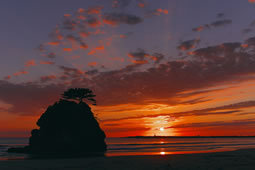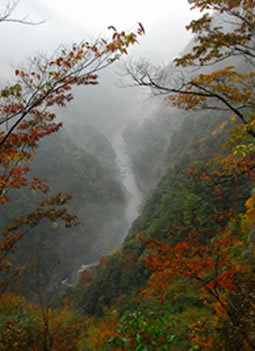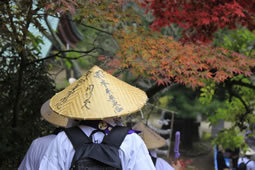
http://www.activetours.co.jp/en/
Mobile Website
Mobile Website
Active Tours
2-3-7 Yahatacho, Musashino, Tokyo 180-0011
TEL:0422-38-8026
FAX:0422-38-8036
TEL:0422-38-8026
FAX:0422-38-8036
005714
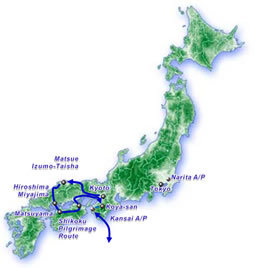
Mythological World is an important element of every nation and tribe in the world. Every nation has mythology conveyed from generation to generation.
In Japan, “Shinto = Kami-Worship” is the world of mythology, later combined with Buddhism, which could reinterpreted the internal aspects of mythological persons. Buddhism in Japan is a religion indispensable to the spirits of Kami-Worship. There are shrines and temples where ancient people felt as the “spiritual spot”, where are often in the depth of woods or on the top of mountains.
12-day Tour from Kyoto to Shikoku 88 pilgrimage route through Izumo;
Visiting popular and famous places related to mythology and Buddhism, by rail, ferry, rope-way and coach.
This program includes the highlights of the western parts of Japan, Izumo, Miyajima and Shikoko Pilgrimage route. Shikoku is Japan’s fourth largest island and the pilgrimage circuit loops around the entire island through 88 temples of Kukai, known as Kobo Daishi. Many people go on pilgrimage to their own practice both in mind and physics, notwithstanding which sect they believe in.
In Japan, “Shinto = Kami-Worship” is the world of mythology, later combined with Buddhism, which could reinterpreted the internal aspects of mythological persons. Buddhism in Japan is a religion indispensable to the spirits of Kami-Worship. There are shrines and temples where ancient people felt as the “spiritual spot”, where are often in the depth of woods or on the top of mountains.
12-day Tour from Kyoto to Shikoku 88 pilgrimage route through Izumo;
Visiting popular and famous places related to mythology and Buddhism, by rail, ferry, rope-way and coach.
This program includes the highlights of the western parts of Japan, Izumo, Miyajima and Shikoko Pilgrimage route. Shikoku is Japan’s fourth largest island and the pilgrimage circuit loops around the entire island through 88 temples of Kukai, known as Kobo Daishi. Many people go on pilgrimage to their own practice both in mind and physics, notwithstanding which sect they believe in.
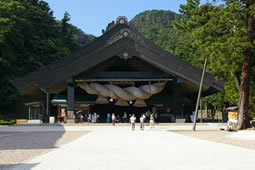
|
TIzumo is referred as “country of mythology”. Izumo Taisha is Japan’s oldest shrine and the place where the Shinto’s eight million “Kami” (Gods) get together once a year in October. The shrine is dedicated to “Okuninushi no Mikoto”, the nephew of the Sun Goddess. “Okuninushi no Mikoto” is the most popular “Kami” (God) or industry, fortune, and above all, marriage.
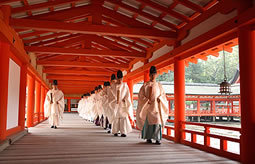
|
Miyajima has been an object of nature worship since ancient times, because of its landscape, and mountains with its dominant Mt. Misen, surrounded by the primeval forest which is dark even in the daytime, making people feel a flow of spirituality. The Itsukushima shrine was founded in 593. The shrine and its torii gate are unique for being built over water, seemingly floating in the sea during high tide.
|
Day 1
Kansai Int’l airport arrival | Kyoto |
Meet and greet by a guide and transfer to Kyoto. (Kyoto)
|
|
Day 2
Tokyo |
Full-day tour of Kyoto, visiting Chion-in Temple, the head temple of the Jodo-sect, one of the important sects in Japan, literally means “pure land” founded by Honen in 1175. Then, Sanju-sangen do & Kiyomizu Temple.
Visit includes tea-ceremony experience. (Kyoto) |
|
Day 3
Tokyo |
Full-day tour of Kyoto, visiting Kinkaku-ji Temple & Shimogamo Shrine, Nijo-jo Castle, and others. (Kyoto) |
|
Day 4
Kyoto | Mtasue |
Board on JR train to Matsue via Okayama. Matsue is known as “water town”, and once Lafcadio Hearn, 19th century author,lived here as an English teacher. Visit Matsue Castle, the Lake Shinji and others. (Matsue) |
|
Day 5
Matsue |
Visit Izumo Taisha (shrine) by train. Izumo Taisha is the oldest and most basic style of shrine architecture. It is the largest shrine in existence in Japan. Then visit Iwami Ginzan, the World Heritage. It is a historic silver mine in the mountains of Oda city, discovered in the early 16th century and was mined for nearly 400 years. (Matsue) |
|
Day 6
Matsue | Hiroshima | Miyajima |
Transfer to Hiroshima over the picturesque Chugoku mountainous area by coach. Upon arrival Hiroshima, city tour, visiting Peace Memorial Park & Museum.
Then, transfer to Miyajima by ferry. (Miyajima) |
|
Day 7
Miyajima | (Hiroshima port) | Matsuyama | Dogo Onsen |
Visit Itsukushima Shrine and the sacred Misen Mountain.
Then board on ferry to Hiroshima pier, and change ferry to Matsuyama across the Seto Inland Sea, enjoying picturesque scenery of small islands floating on the sea. (Dogo-Onsen) |
|
Day 8
Matsuyama | Takamatsu |
Start visiting several temples on the pilgrimage route.
Visit Zentsu-ji, the birthplace of Kukai (kobodaishi), who built it in 807 when he returned from China, named after his father. Other temples to be chosen and visited according to season, weather and other conditions. (Takamatsu) |
|
Day 9
Takamatsu |
Visit Kompira-san (Kotohira-gu Shrine). Kompira-san (formally Kotohira-gu) is the main shrine of multiple Kompira shrines found around Japan that are dedicated to sailors and seafaring. Located on the wooded slope of Mount Zozu in Kotohira, the approach to Kompira-san is an arduous series of 1,368 stone steps. Then to Iya-valley, in the hidden mountain regions, said to be one of the most scenic spots in Western Japan. (Takamatsu) |
|
Day 10
Takamatsu | Osaka | Koya-san | (Mt. Koya) |
Leave for Osaka through Seto-Ohashi Bridge, the largest combined road & rail bridge system in the world in terms of scale. Upon arrival Kurashiki, board on JR Shinkansen to Osaka.Upon arrival Osaka, proceed to Koya-san.
Most people, finished Shikoku pilgrimage, visit Koya-san for express thanks for the safejourney. Overnight at “Shukubo” in Koya-san, with “Shojin-Ryori” Dinner. |
|
Day 11
Koya-san | Osaka |
Visit Okuno-in, the mausoleum of Kukai. On the both sides of cemetery path, a half million tombs develop impressive aspect. Then visit Kongo-bu-ji complex, head- quarter of the Shingon-shu (sect). Evening, descend the mountain by cable-car and take a train for Osaka. (Osaka) |
| Day 12 Osaka | Kansai Int’l Airport (KIX) |
Transfer to Kansai International Airport by coach.
Tour ends at airport. |





